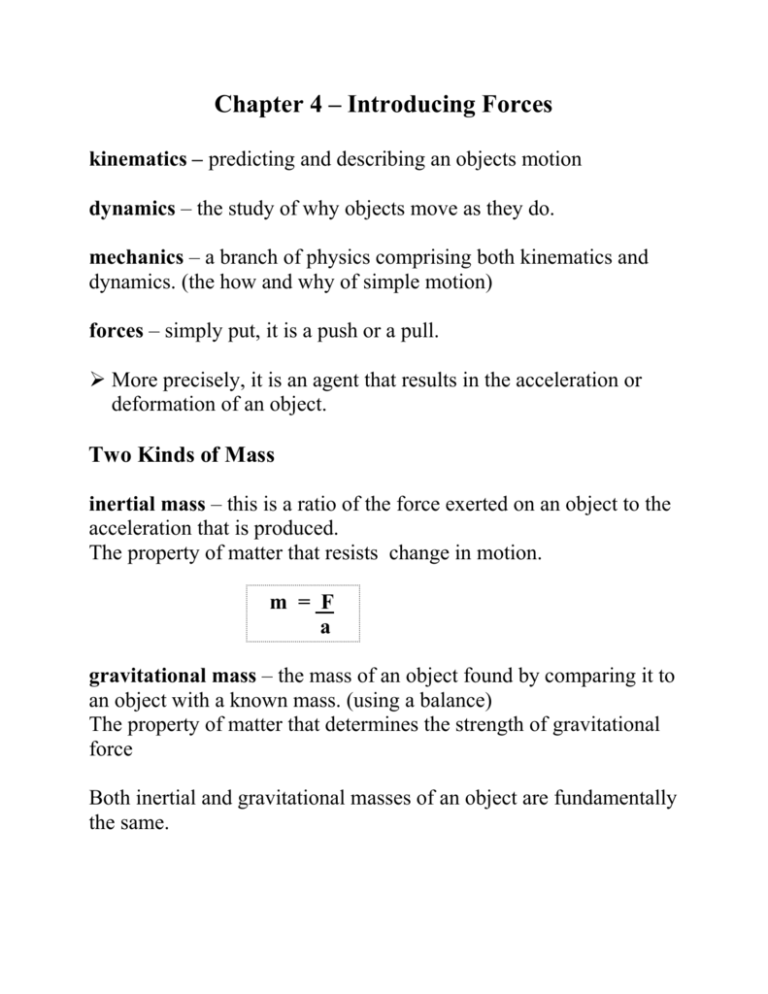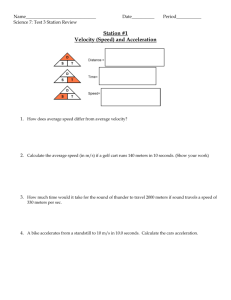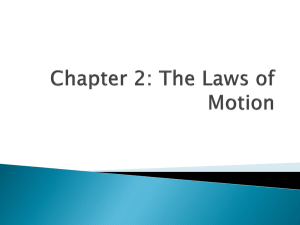Chapter 4
advertisement

Chapter 4 – Introducing Forces kinematics – predicting and describing an objects motion dynamics – the study of why objects move as they do. mechanics – a branch of physics comprising both kinematics and dynamics. (the how and why of simple motion) forces – simply put, it is a push or a pull. More precisely, it is an agent that results in the acceleration or deformation of an object. Two Kinds of Mass inertial mass – this is a ratio of the force exerted on an object to the acceleration that is produced. The property of matter that resists change in motion. m = F a gravitational mass – the mass of an object found by comparing it to an object with a known mass. (using a balance) The property of matter that determines the strength of gravitational force Both inertial and gravitational masses of an object are fundamentally the same. Common Forces Objects interact with other objects by exerting forces on each other. There are both contact and non-contact forces. contact force – the force exerted by an object in direct contact with another object. non-contact force – the force that even though objects are separated by a distance, such as the attraction or repulsion between magnets. Gravitational Force There is a mutual force of attraction that exists between any two masses. You do not notice this force, let’s say between two tennis balls, because their masses are so small. But you are very much aware of this force if you jump off your house. The force of gravity is due to the enormous mass of the earth. However, you also exert a force of attraction on the earth. This gravitational force acts on a line between the center of both objects, and the strength of the force both weakens as the distance between the objects increases or the masses decrease. This force never truly reaches zero. Mass, Weight and Gravity acceleration due to gravity (g) – the acceleration of an object towards the center of a planet due to the gravitational force between the planet and the object. The value of g on the earth’s surface is approx. 9.81 m/s2, but ranges between 9.7805 and 9.8322 m/s2 because the earth is not perfectly round. The value of g also varies significantly. moon – 1.64 m/s2 mars – 3.72 m/s2 jupiter – 25.9 m/s2 weight (Fg)– is a measure of the gravitational force acting on a mass. Fg = m g What is the weight of a 1.00 kg object on earth? Fg = m g Fg = (1.00 kg) (-9.81 m/s2) Fg = -9.81 kg m/s2 1 Newton (N) = 1 kg m/s2 Fg = - 9.81 N Acceleration due to gravity and the gravitational force are equal in magnitude. Weight is a force, and forces are vector quantities, therefore weight is a vector quantity. Since weight is a measure of the gravitational force (pull of gravity), the weight will change as the gravitational force changes. ie. From the values of g above, we see that a 1.00 kg mass on the moon would only have a weight of 1.64 N. However, the force needed to accelerate a mass on the moon is the same as on earth, because the objects mass stays constant. Friction friction (contact force) – this a force that opposes motion and acts between two surfaces that are in contact with each other. Friction is actually an electromagnetic force acting between the atoms of one object and those of another. The direction of the force is parallel to the surface and in a direction that opposes the slipping of the two surfaces. Friction is very useful in some cases and in others we try to eliminate it It has been found that the force of friction (Ff) depends on two things: 1) the force pushing the two surfaces together. (Weight - Fg) 2) the type of surfaces that are in contact with each other. * It does not depend on the area of the surfaces that are in contact, if the mass of the object is evenly distributed. * Certain plastics and rubbers have properties that often do not fit the standard model of friction. * If one surface has ridges that allow one surface to penetrate another, frictional principles no longer apply. There are two types of frictional force. 1. static frictional force – the force that acts to keep an object at rest and is measured as the force required to move an object from rest. 2. kinetic frictional force – the force that acts to slow the motion of an object and is measured as the force required to keep an object sliding over another object. The amount of force needed to start an object moving or overcome static friction is greater than the force needed to keep it moving. static friction > kinetic friction To keep an object moving at a constant velocity, a force must continually be applied, (Fa) that is equal to the kinetic friction. Fa = Ff (constant velocity) There is a value called the coefficient of friction (µ - mu) that relates the Ff and Fg . It depends entirely on the two interacting surfaces. The coefficients of static and kinetic friction are different. The coefficient of static friction is always greater than that of kinetic friction. µ = Ff Fg When an object is on a horizontal surface, Fg = FN (normal force – acts perpendicular to the surface) µ = Ff FN Free Body Diagrams When several forces are acting on a body, it is sometimes difficult to determine which if any of the forces will change the object’s state of motion. You have to consider all forces and find the vector sum of all the forces to predict the motion. The vector sum is called the net force. A free body diagram is used to show all forces acting on a single object. Rules for drawing free body diagrams : 1. Forces that the object exerts on other objects are not put in the diagram. 2. Represent the object as a single dot. 3. Represent each force acting on the object with an arrow. (vector) 4. Direction of arrow should be the same as the direction of the force and the length of the arrow should represent the magnitude of the force.







